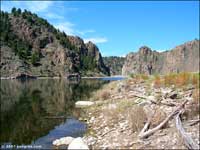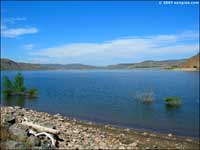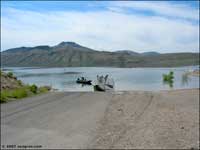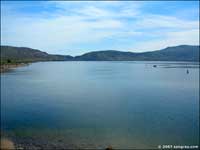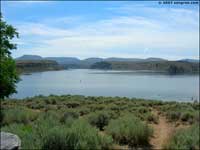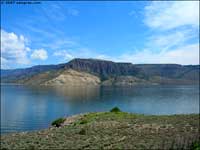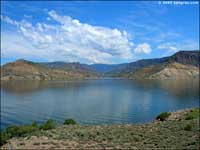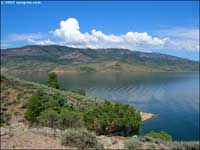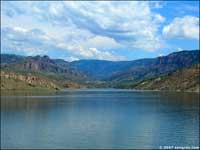
The West Elk Loop Scenic Byway
Blue Mesa Reservoir
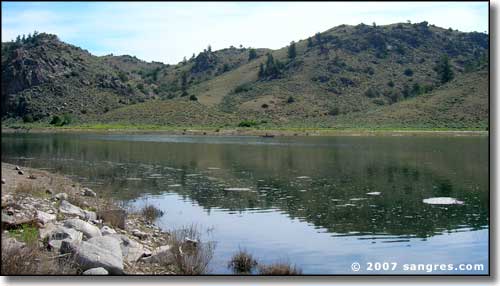
Summer 2006, the lake is pretty high (just west of Gunnison)
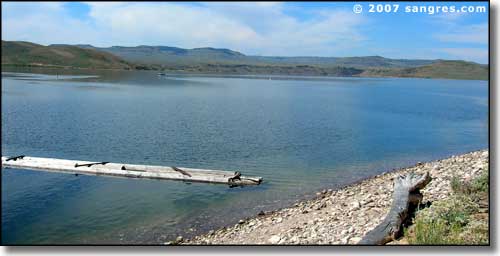
Looking west near Stevens Creek
Blue Mesa Reservoir is the largest lake in Colorado. It is also the highest and most popular of the three lakes formed by damming the Gunnison River in stages during the 1960's and 1970's. As part of the Curecanti National Recreation Area, it is managed by the National Park Service (Curecanti is named for the Ute Indian chief Curicata). No Colorado vacation would be complete without a drive and a few stops along this beautiful and historic Scenic Byway in the very heart of the Colorado mountains.
Completed in October, 1965, Blue Mesa Dam is a 342-foot-high compacted earth and rock structure. At its greatest storage capacity (7,519' in elevation), Blue Mesa Lake is a 9,000-acre lake with some 96 miles of shoreline. Blue Mesa drowned three broad basins: Iola, Cebolla and Sapinero, that were previously occupied by elk, deer and the Gold Medal Trout Waters of the meandering Gunnison River. With the drowning of the necessary trout spawning gravel areas, the Colorado Division of Wildlife has taken over stocking Blue Mesa with some 900,000 small rainbows and over 1,000,000 small kokanees each year (the kokanee fry are actually put into the river at the Roaring Judy Fish Hatchery near Gunnison and allowed to float down to the lake in the dark of the moon, then when spawning time comes, they make their way back upstream to the Roaring Judy where they are artificially spawned and the cycle begins again). In terms of the numbers of fish caught each year at Blue Mesa, first are the rainbows with kokanee salmon running a close second, followed in much lower numbers by brown and brook trout and Mackinaws (lake trout, sometimes growing to 30 pounds).
Blue Mesa is also frequented by several pairs of bald eagles and a sizable "flock" of great blue herons. As the great blue herons return to the same nests year after year, their rookery grows and can be seen well from the Neversink Trail and the Cooper Ranch area.
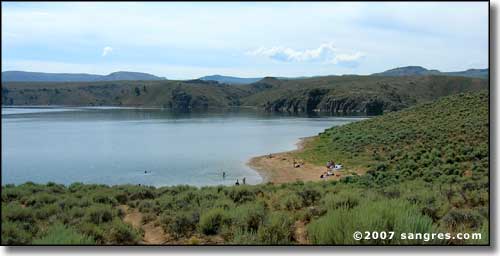
A beach on a quiet cove

The Elk Creek Camping Area

February on the reservoir...

...and the fishing is still good
The Gunnison River spent about 2 million years carving a deep, narrow canyon into the hard rock downstream from Blue Mesa. But the Blue Mesa area is composed of much softer sandstones, limestones and shales left over after millenia of deposition by ancient rivers and seas. The Morrison Formation lies along the lakeshore in many areas. This layer of reddish-green shale is famous for the wealth of fossils it contains (including many of the most famous dinosaur skeletons found in the western states). Even today, visitors to the area are finding new areas of dinosaur bones and fossilized plant remains. Just above the Morrison is a thin layer of Dakota Sandstone topped by the loose material of the Mancos shale. The Mancos shale is given to landslides and to turning into a gooey muck when wet, this is why the Soap Creek Arm is named the way it is: lots of Mancos shale is showing here.
Above the sedimentary rocks are the volcanic rocks from 25 to 30 million years ago. About 30 million years ago the West Elk Volcano erupted and spewed lava, rock and mud up to 600 feet thick in some places. Over time this solidified into the West Elk Breccia which then eroded into formations like the Dillon Pinnacles: spires and towers of cemented brecchia materials. Above the West Elk Brecchia is a layer of volcanic rock deposited when the San Juan Mountains to the south erupted and spewed ash, pumice, and crystals of feldspar and other minerals all over the area. When this stuff cooled, it left a layer of dense, obsidian-like material filled with cavities caused by the former presence of bubbles of super-heated gases known as "tuff." In the years since, this tuff has eroded in places and allowed the action of wind and water to reach into the layers of West Elk Brecchia and give us the forms we now know as "the Dillon Pinnacles."
This volcanic activity also caused the Gunnison River to detour around the base of the West Elk Mountains and carve out its canyon in the heart of the Gunnison Uplift: very hard metamorphic and igneous basement rocks more than a billion years old. This part of the story continues downstream in the part of the Curecanti National Recreation Area known as Morrow Point Lake.
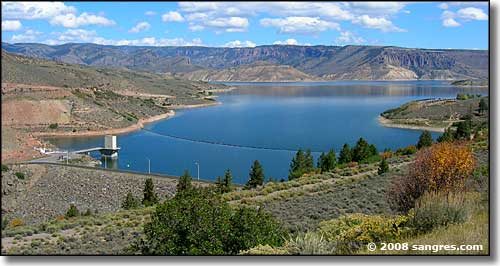
To return, use the Back button in your browser.
